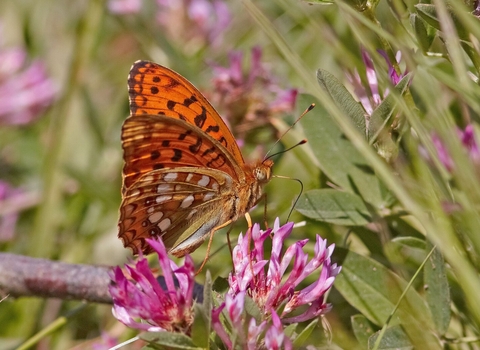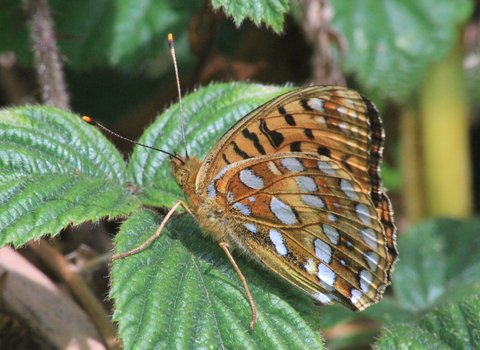
High brown fritillary © Stefan Johansson

High brown fritillary © Tom Hibbert
High brown fritillary
Considered Britain's most threatened butterfly, the high brown fritillary can be only be found in a few areas of England and Wales.
Scientific name
Fabriciana adippeWhen to see
June to AugustSpecies information
Category
Statistics
Wingspan: 60-67mmUK BAP: Priority Species. Section 41 species of principal importance under the NERC Act in England. Listed on Section 7 of the Environment (Wales) Act 2016. Protected in the UK under the Wildlife and Countryside Act, 1981.
About
The high brown fritillary is a large orange butterfly with intricate black markings, similar to several other species of fritillary. High brown fritillaries are found in woodland clearings and grassy areas on moorland slopes, where there is a mosaic of dense bracken and grassy patches; or on outcrops of limestone rock where woodland or scrub has recently been cleared.They depend on the presence of violets, which their caterpillars feed on. Common dog-violet is often used, but in limestone rock areas they will also use hairy violet. Caterpillars have also been recorded feeding on heath and pale dog-violets.
Adult butterflies emerge throughout June. They have a fast, powerful flight and are often seen rushing over the tops of bracken and other low vegetation, where they can be tricky to tell apart from the similar dark green fritillary. They're much easier to identify and admire when they stop to take nectar from the flowers of brambles, thistles or knapweeds.
Female high brown fritillaries lay their eggs on leaf litter, often dead bracken leaves - though moss can be used in limestone outcrops. They'll spend the winter in this state, before hatching in early spring to feed on the leaves of nearby violets. The spiny brown caterpillars blend in perfectly with dead bracken fronds on the ground, which they often use as sunbathing spots - these basking sites can be 15-20°C warmer than the surrounding area! After a couple of months, they pupate close to the ground, hanging from a pad of silk stuck to the underside of a leaf or stem.
High brown fritillaries were once found throughout England and Wales, but have declined dramatically both in abundance and in the number of areas they occur. Between 1976 and 2014, the UK population plummeted by 62% - and it's likely that the decline began even earlier than this. A lot of targeted conservation work is helping high brown fritillaries hang on in their few remaining strongholds, with some positive signs that these populations may be stabilising.
How to identify
A large butterfly with orange upperwings covered in black markings. The underside of the hindwings has a scattering of silver-white markings, with a row of silver-centred, red-brown spots towards the outer edge of the wing.High brown fritillaries are very similar to dark green fritillaries, which can be seen flying at the same time and in the same habitat. The best feature for distinguishing the two is the row of red-brown spots on the underside of the high brown's hind wing, which dark green fritillaries lack.
